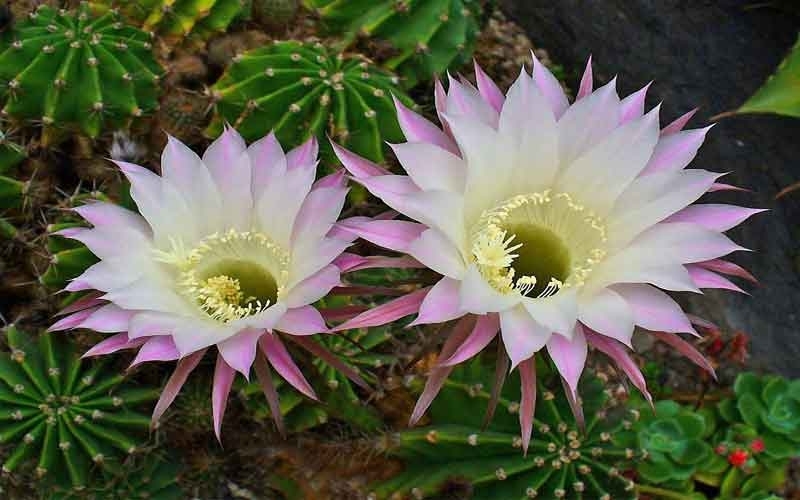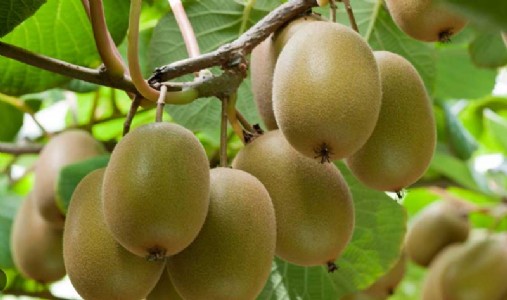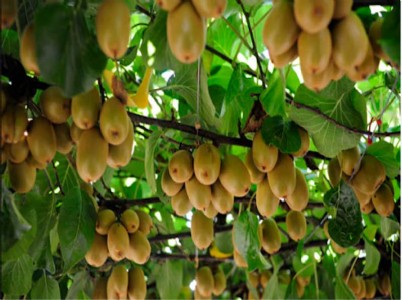Enter your Email Address to subscribe to our newsletters
Easter Lily Cactus: A Thorn Beauty

Dr. Palagani Neelima
Easter lily cactus, sea-urchin cactus and night-blooming hedge-hogs are common names for Echinopsisoxygona. As its common name (Easter Lily Cactus), they bloom in the spring, around Easter. The scientific name Echinopsisoxygona comes from the Greek words “ehinus” which means hedgehog and “opsis” which means long spines and forms. This is a Native of Mexico and South America. It is an evergreen, perennial with attractive flowering spherical cactus that belongs to the Cactaceae family and is planted as an ornamental plant. The hybrids are known for their fragrant blossoms, which come in a number of colours including white, pink, and yellow, as well as a variety of colour variations.
Details of the plant
The size of this fast-growing cactus group ranges from small, low-growing globe-shaped plants to large, column-like branching specimens. Its stem measures 30 cm in height with 10 to 18 straight ribs and a diameter of up to 25 cm. The white areoles have strong spines.
The blooms are large and beautiful, with sharply pointed white, pink, or yellow colours and develop at the tips of the stems and the blossom has a magnificent fragrance. The fruit type is a green berry. In most cases, these cacti can live for a very long period of time.

Uses
They are planted primarily for their beautiful flowers, which bloom at night and close up during the day. The flowers remain fresh for one or two days. It can be grown in rock and cactus gardens as well as along paths, in containers or as a filtered shade understory plant. The Easter lily cactus is a spectacular plant that should be employed in a landscape for its extraordinary spring colour display.
Propagation
The plant is propagated by offsets and seeds.
Offsets propagation
One offset should be cut adjacent to the very base, where it connects to the mother stem. Place it on a cloth and leave it to form a callus at the incision site for a few days. In the container already filled with the soil and sand mixture, place the offset. Place the pot in a sunny but protected area away from direct sunlight to avoid the substrate from drying out. For the first month, do not irrigate at all. The moisture in the substrate is sufficient for the plant to establish a root. The plant has begun to grow when you observe a fresh green tint and new thorns on the top of the offset.
Seeds propagation
Early spring is the best time to start growing from seed. Fill a clean 4-inch bowl with a sand and substrate mixture. Distribute the seeds evenly throughout the area and cover them with a one-sixth inch layer of soil. Distribute the seeds uniformly over the space and cover them with a sixth-inch layer of dirt. Spread the seeds uniformly across the space and cover them with a 0.5 cm layer of fine soil. Keep the seeds in the container in a bright, warm location away from direct sunlight.
Germination takes a few weeks to several months and is sporadic. Water the seedlings gently with little amounts of water as seedlings appear. Transplant the seedlings into small individual pots once the seedlings have developed to the stage where they can be handled easily.
Precautions during propagation and transplanting
When dealing with cacti, be cautious and take precautions because their sharp spines make them difficult to handle, especially when they are small offsets. Garden gloves are insufficient because the thorns can easily penetrate them. Use thick safety gloves made of hard materials such as genuine uncut leather, comparable to those worn by construction workers. Avoid touching the cactus with hands. It’s also a good idea to wrap it with multiple layers of paper or thicker cloth when propagating or transplanting it.
Soil requirements
The best soil for growing ester lily cactus is light and well-drained soil. Plants have the ability to grow in situations where there is a scarcity of water. Soil that has been moist for a prolonged duration of time is inappropriate for growing plants. To improve the permeability of the substrate, combine a normal substrate with sand in equal proportions.
Light and temperature
It is a desert plant that requires a lot of direct sunlight to thrive. If there is inadequate light, the plant will not die, but it will spread toward the light source and flowering will not occur. Take it outside in the summer to a sunny location. However, do not expose it to direct sunlight immediately; instead, keep it in a partially shaded area for the first two or three days to allow it to acclimatize. The optimum temperature at which it thrives ranges between13 and 370C.
Humidity
It prefers dry air and can tolerate a slightly higher humidity level. In an extreme case, the humidity of the location does not significantly affect its growth and development. A normal humidity level of 30 to 50%, to which it responds fast and effortlessly.
Irrigation
Despite having its own water storage in its thicker stems, this cactus still requires irrigation, though not to the amount that other foliage plants require. During the hot summer months, as the species is drought-resistant requires very less irrigation. Irrigate sparingly but frequently during the growing season, once every 10 or more days if the plant is on a sunny window sill. Irrigate once or twice over the winter, just in case the substrate is absolutely dry.
Pruning season
Dead stem parts and flowers are pruned throughout the year.
Application of fertilizer
Use liquid fertiliser dissolved in water, and apply fertilizer two or three times during the growing season. Use a regular fertilizer with a balanced NPK ratio or a cactus-specific fertilizer. Because phosphorus promotes flowering, use fertilizers with a little higher phosphorus content before the plant blooms.
Potting
Because the plant has a poorly established root system that expands more horizontally than vertically, shallow and wide pots are best for planting. A deep container is not recommended for planting because of the shallow roots of the plants. The drainage layer at the bottom of any container, regardless of the type of container, is chosen. A layer of large pebbles or broken tiles over the hole will allow for quick drainage, preventing the plant from becoming overwatered. Because clay is porous and absorbs moisture from the substrate, it is ideal to grow Echinopsisoxygona in a pot made of natural materials like clay.

Repotting
It does not require frequent transplanting. It’s enough to repot it every second or third year when it entirely outgrows the pot. There is never a surplus of space in rock fissures, where it generally develops in nature, thus compaction will not hinder it. Plants can live for years in the same container.
Pest and diseases
Plants are usually hardy and resistant to pests and diseases. Mealybugs and red spiders appear. However, these are rare occurrences. The problem can be solved with a simple treatment of natural insecticides such as neem oil.
Problems
Root rot is caused by the over-irrigation of plants. The process starts underground and quickly spreads to the stems, causing them to become soft and mushy. Unfortunately, the condition is so damaging that it causes the stem tissue to deteriorate.
Control: Remove the plant out of the moist substrate. Examine the root ball for decaying veins and remove them. Wrap the root of the plant in a paper towel to absorb any excess moisture. Allow the plant to dry out in the shade for two or three days to allow excess moisture to evaporate. Replace the plant in the substrate, but don’t water it for another month.
Dry, shrivelled edges of the lobes
Plants can tolerate prolonged droughts, but it does not imply they should be left without water for weeks at a time. The plant will begin to consume the water held in the stems once it has drained all of the water from the substrate. The lack of water will first be noticeable at the edges of the lobes, which will begin to change colour, dry out, and wither as a result of the lack of water. The plant will die if it does not receive enough moisture.
This beautiful, flowering cactus can be easily grown in the home gardens, in the lobby, in windows, as a plant in terrarium gardens or mini gardens, etc.










